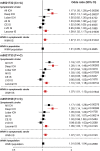Common variation in COL4A1/COL4A2 is associated with sporadic cerebral small vessel disease
- PMID: 25653287
- PMCID: PMC4351667
- DOI: 10.1212/WNL.0000000000001309
Common variation in COL4A1/COL4A2 is associated with sporadic cerebral small vessel disease
Abstract
Objectives: We hypothesized that common variants in the collagen genes COL4A1/COL4A2 are associated with sporadic forms of cerebral small vessel disease.
Methods: We conducted meta-analyses of existing genotype data among individuals of European ancestry to determine associations of 1,070 common single nucleotide polymorphisms (SNPs) in the COL4A1/COL4A2 genomic region with the following: intracerebral hemorrhage and its subtypes (deep, lobar) (1,545 cases, 1,485 controls); ischemic stroke and its subtypes (cardioembolic, large vessel disease, lacunar) (12,389 cases, 62,004 controls); and white matter hyperintensities (2,733 individuals with ischemic stroke and 9,361 from population-based cohorts with brain MRI data). We calculated a statistical significance threshold that accounted for multiple testing and linkage disequilibrium between SNPs (p < 0.000084).
Results: Three intronic SNPs in COL4A2 were significantly associated with deep intracerebral hemorrhage (lead SNP odds ratio [OR] 1.29, 95% confidence interval [CI] 1.14-1.46, p = 0.00003; r(2) > 0.9 between SNPs). Although SNPs associated with deep intracerebral hemorrhage did not reach our significance threshold for association with lacunar ischemic stroke (lead SNP OR 1.10, 95% CI 1.03-1.18, p = 0.0073), and with white matter hyperintensity volume in symptomatic ischemic stroke patients (lead SNP OR 1.07, 95% CI 1.01-1.13, p = 0.016), the direction of association was the same. There was no convincing evidence of association with white matter hyperintensities in population-based studies or with non-small vessel disease cerebrovascular phenotypes.
Conclusions: Our results indicate an association between common variation in the COL4A2 gene and symptomatic small vessel disease, particularly deep intracerebral hemorrhage. These findings merit replication studies, including in ethnic groups of non-European ancestry.
© 2015 American Academy of Neurology.
Figures



References
-
- Pantoni L. Cerebral small vessel disease: from pathogenesis and clinical characteristics to therapeutic challenges. Lancet Neurol 2010;9:689–701. - PubMed
-
- Woo D, Falcone GJ, Devan WJ, et al. Meta-analysis of genome-wide association studies identifies 1q22 as a novel susceptibility locus for intracerebral hemorrhage. Am J Hum Genet 2014;94:511–521. 10.1016/j.ajhg.2014.02.012. - DOI - PMC - PubMed
Publication types
MeSH terms
Substances
Grants and funding
- K23 NS086873/NS/NINDS NIH HHS/United States
- 095626/WT_/Wellcome Trust/United Kingdom
- BB_/Biotechnology and Biological Sciences Research Council/United Kingdom
- MR/K026992/1/MRC_/Medical Research Council/United Kingdom
- R01 HL105756/HL/NHLBI NIH HHS/United States
- R01 AG008122/AG/NIA NIH HHS/United States
- R01 AG033193/AG/NIA NIH HHS/United States
- R01 NS059727/NS/NINDS NIH HHS/United States
- R01NS059727/NS/NINDS NIH HHS/United States
- OSRP2/1006/DMT_/The Dunhill Medical Trust/United Kingdom
- U01 NS036695/NS/NINDS NIH HHS/United States
- U01 AG049505/AG/NIA NIH HHS/United States
- K23NS086873/NS/NINDS NIH HHS/United States
- P50NS061343/NS/NINDS NIH HHS/United States
LinkOut - more resources
Full Text Sources
